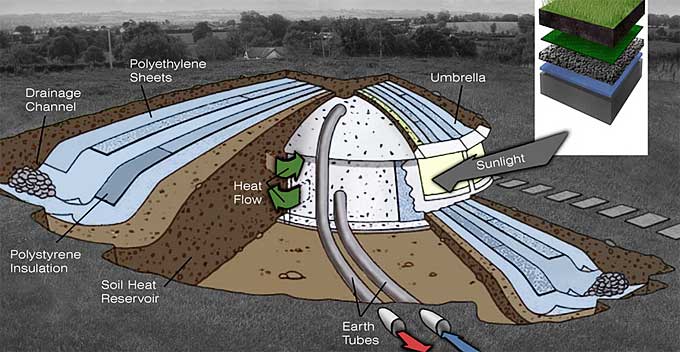Dealing
with Moisture
One of the most common issues with underground homes
is controlling the water that can adversely affect the
home's structure and livability.
|
|
 Moisture in underground homes
Moisture in underground homes |
Every single water source and everyplace in the home
where water might end up will need individual attention
to make sure that your home is watertight.
Water problems come from various sources, including:
- Running surface water
- Stagnant surface water
- Rain water
- Water that flows over your home
- Subsurface water pooling on your roof
- Excess water in your drainage system
- Water that flows in the earth all around your home
- Soil moisture
- Natural water in the area water table
- Plumbing issues
- Indoor water-use units like kitchens and bathrooms
The water that affects your home can damage it in
various ways. They include:
- Swamp or desert-like conditions at the surface
- Erosion
- Waterproofing failures, dripping or dampness in your
home
- Structural failures
- Mildew, mold and insects
- Underground drainage clogs
- Humid or dry interiors
- Drains that can flood or back up
- Losing stored heat
The first step many builders use is to keep the water
on the surface away from your home. Sculpting the land
around your home will help to steer the runoff into areas
where it won't be a problem. Adjusting your position if
you're building on a slope will also help keep surface
water from becoming an issue.
Storm drains in your home should also be of suitable design
that they won't become clogged with leaves or other debris.
All water needs to be drained away if you don't want to
have water problems in your underground home.
On Golden Pond ...
You'll want to avoid ponding on the roof of your home,
too. When it pools, it puts pressure on the roof, and
this can cause structural failure. This is easily avoided
by the use of a roof placed on your home at an angle that
allows water to run off. Dome shapes also are stronger
and shed water well.
Water may also collect at the points where your home
meets the earth. This intersection includes waterproofing
and flashing, and weep holes can help keep water from
building up behind retaining walls.
Earth sheltered houses can also be more eye-appealing
if you have adult vegetation on the roof and around the
home, instead of just grass. The roots of mature trees
will use some of the water that might otherwise be a problem.
Be sure not to select trees or other plants with excessive
root systems, or they may interfere with the home.

Underground Umbrella Home
Umbrella Protection ...
A watershed/insulation umbrella can help you in solving
various water problems around your home. Keep the moisture
levels where you want them by placing your umbrella between
the top earth layer and the storage zone. This will be
helpful to keep the earth berm around your home dry. These
umbrellas are typically made from three plastic layers
with insulation between them.
It may also be beneficial to install a gravel layer around
the outside of your umbrella, rather than a drain tile.
Drain tiles tend to move water too quickly, while gravel
only allows excess water to drain off, which keeps needed
water in your moderation zone, for your plants. It's the
best of both words in controlling the water that you don't
want inside your earth-sheltered home.
Written by Kevin Knatloa
First Published on November 05, 2012
Updated November 22, 2013
|